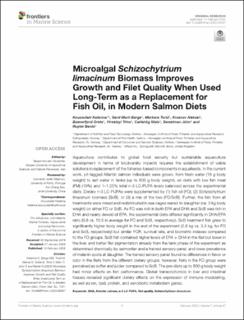| dc.description.abstract | Aquaculture contributes to global food security but sustainable aquaculture development in terms of biodiversity impacts requires the establishment of viable solutions in replacement of the fisheries-based components in aquafeeds. In the current work, pit-tagged Atlantic salmon individuals were grown, from fresh water (18 g body weight) to salt water in tanks (up to 800 g body weight), on diets with low fish meal (FM) (10%) and 1–1.25% total n-3 LC-PUFA levels balanced across the experimental diets. Dietary n-3 LC-PUFAs were supplemented by (1) fish oil (FO), (2) Schizochytrium limacinum biomass (ScB), or (3) a mix of the two (FO/ScB). Further, the fish from all treatments were mixed and redistributed in sea cages reared to slaughter (ca. 3 kg body weight) on either FO or ScB. As FO was rich in both EPA and DHA and ScB was rich in DHA and nearly devoid of EPA, the experimental diets differed significantly in DHA/EPA ratio (0.8 vs. 10.5 in average for FO and ScB, respectively). ScB treatment fish grew to significantly higher body weight in the end of the experiment (2.8 kg vs. 3.3 kg, for FO and ScB, respectively) but similar FCR, survival rate, and biometric indexes compared to the FO groups. ScB fish contained higher levels of EPA + DHA in the filet but lower in the liver, and better filet pigmentation already from the tank phase of the experiment as determined chemically, by salmonfan and a trained sensory panel, and lower prevalence of melanin spots at slaughter. The trained sensory panel found no differences in flavor or odor in the filets from the different dietary groups; however, filets in the FO group were perceived as softer and juicier compared to ScB. The pre-diets up to 800 g body weight had minor effects on fish performance. Global transcriptomics in liver and intestinal tissues revealed significant dietary effects on the expression of immune modulating, as well as ion, lipid, protein, and xenobiotic metabolism genes. | |
